Growing veg – the 8 mistakes you can easily avoid
I am officially no good at growing veg.
So I’m not going to tell you how to grow any individual vegetable – there are lots of other excellent bloggers and YouTubers who can do that. At the bottom of this post, there’s a list of useful posts, videos and books to help you grow vegetables.
But I am going to tell you the things you really need to know. I’ve made all the mistakes so you don’t have to.
Growing veg is easy…BUT
My friend Lesley who is a lawyer with an excellent vegetable patch, has been through the learning curve. She has come out the other side as an excellent vegetable grower and has sent me a list of tips which are so helpful. So we’ll start with those.
But first, you will read that vegetable growing is easy.
Technically, it is. Popular veg, such as carrots, potatoes, beans and lettuce do well on pretty much any soil all around the world. That’s why they’re popular.
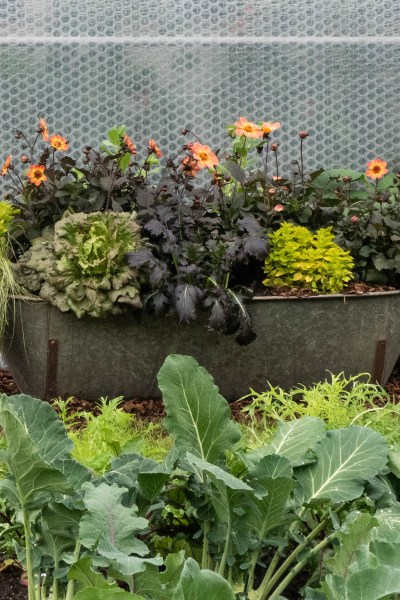
Lettuces and cabbages growing with dahlias at BBC Gardeners World Live. Salad leaves are the easiest veg to start with.
Most of the techniques such as potting on or deadheading (known as ‘harvesting’ in the veg world) are exactly the same as for flowers.
Growing vegetables involves planting a seed, watering it, protecting it from anything else that wants to eat it, feeding it and then harvesting it. There is not a great deal else.
But -and this is a very big BUT indeed. Vegetables and to a lesser extent fruit, require regular attention in the way a flower border doesn’t.
If you put in two hours on a border one weekend, but don’t get back to that border for three or four weeks, then it’ll probably look pretty good. If you do that in your veg patch you will lose the harvest. I know, I’ve done it.
So at least check your veg – every day or every other day – and you are very likely to have a good harvest.
Not everything will work
And secondly, however good a veg grower you are, you will still have failures.
‘Sometimes it’s the weather. Sometimes it’s a dud batch of seeds or seedlings. But you can’t control everything,’ says Lesley.
So if you’ve failed with growing vegetables in the past, it probably wasn’t your fault. Or not wholly your fault, anyway.
Don’t beat yourself up about it. Give it another go, but remember to keep a regular eye on it.
Veg love sun
When I was a child, vegetable patches were hidden out of sight.
But the gardens of even quite modest houses were so much bigger in those days. Out of sight still meant sunny.
If you hide your veg out of sight in an average urban or suburban garden today, the chances are that it will be in quite a shady spot, with overhanging trees or a nearby shed blocking out the sunlight. That’s no good for growing most vegetables, although salad and leaves like some shade.
You have various options. I have friends who put their vegetables beds on the lawn in the middle of the garden. They appreciate the beauty of growing veg.
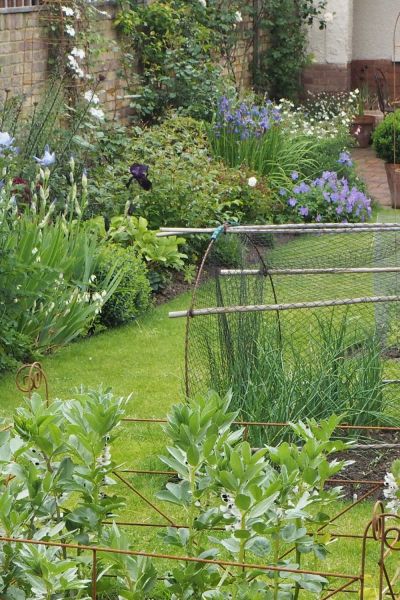
My friend Sarah’s garden has a veg bed in the middle of the lawn and it looks very attractive.
Or you can turn your sunniest border over to veg.
You can grow veg and flowers in the same border, with bean teepees and curly kale mixing with the perennials.
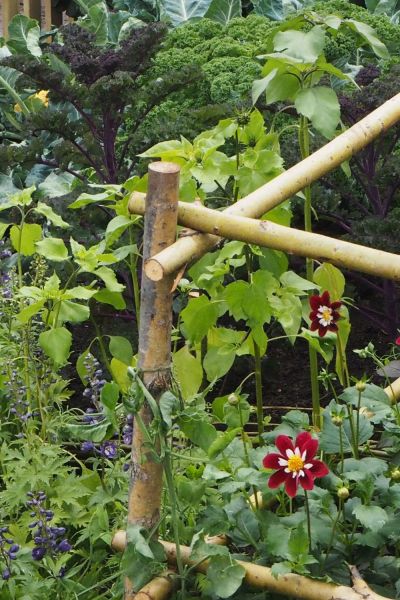
Kale and dahlias in the same border.
Or you can grow veg in pots and put the pots in a sunny spot. Use quite shallow pots for lettuce and salad leaves but really big pots for courgettes, beans and potatoes.
So you have choices. But do not think you can get away with planting anything, except lettuce and salad leaves, in a shady spot.
Prepare your soul
When I read this in Lesley’s email, I was slightly puzzled. But then I checked with her. She meant ‘prepare your soil.’ Both are important.
I can only advise you on preparing your soil. A layer of well rotted manure or garden compost will do your soil a great deal of good. You can choose to go ‘no dig’ or prepare soil in the traditional way. See the bottom of this post for videos, blog posts and books which will help you with this.
Lesley says that every vegetable she has ever known adores mushroom compost.
And you can also use lawn clippings as a mulch around vegetables, fruit and shrubs. Don’t lay it on too thickly – just an inch or so will do.
As for your soul…over to you.
Water and fertilise regularly.
Seeds, seedlings and small plants need regular watering. Once a plant, such as a courgette, gets to full size, its roots are longer and its leaves are big enough to help stop evaporation from the sun.
But until then, it’s important not to let veg plants dry out. ‘Little and often is much better than lots infrequently,’ says Lesley.
And veg need more fertiliser than flowers do. As veg growing expert Charles Dowding often says: ‘Vegetables are the Olympic athletes of the plant world.’
Lesley uses liquid seaweed fertiliser. There are various vegetable plant feeds on the market – I’ve used Baby Bio Outdoor Fruit & Vegetable Feed successfully. And I’ve also successfully used Maxicrop Original Extract. Note that links to Amazon are affiliate, so I may get a small fee if you buy, but it won’t affect the price you pay.
While garden centres are closed, you can buy online although there may be some delivery delays. It’s also worth trying your local plant nurseries, as many are still able to do local deliveries or can post smaller products like seeds.
To make fertiliser at home, see my post on 5 homemade garden fertilisers or see the video on homemade fertilisers.
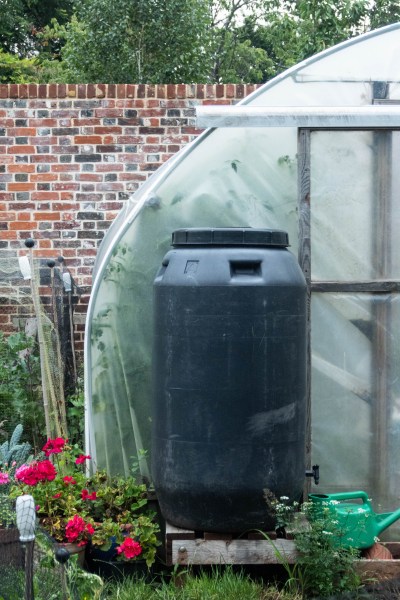
At the Abbey Physic Garden in Faversham, they make homemade fertilisers in this water butt.
I carried out a test one summer where I fed some plants with liquid fertiliser. I used Baby Bio Outdoor Feed, as they were sponsoring the test. And I compared the fed plants to a control set of plants which I didn’t feed with any fertiliser.
The difference was major and you can read about it in 6 sure-fire ways to harvest more grow-your-own veg. For example, there were two courgette plants, planted from the same seed packet at the same time and given the same treatment except for the feed.
Although I was only testing one brand of liquid feed product, I think we can safely say that feeding your vegetable plants makes a very big difference to your harvests. I had 12 courgettes from the fed plant and only 7 from the one which wasn’t fed.
Weed vigilantly
Lesley says that you need to weed a veg patch more more than you do a flower border. Veggies hate competition even from the smallest weeds.
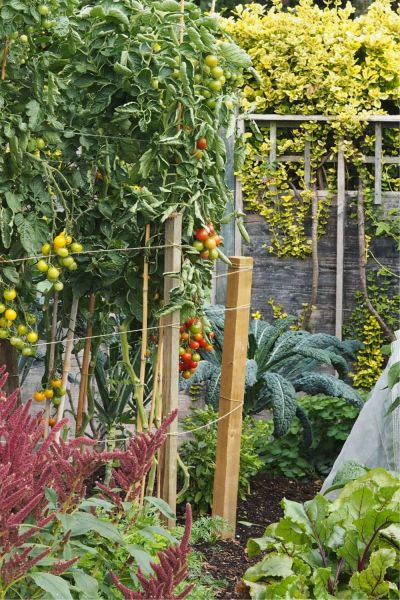
This is the ‘small garden’ at Charles Dowding’s Homeacres. It is planted very intensively – he grows a lot in a very small space. But it is kept well watered, the soil is beautifully nourished and Charles has a zero tolerance approach to weeds.
Once again, that’s because veg need more nutrition than flowers do.
I love self-seeded flowers and even enjoy some weeds in my flower borders. But I have let my veg patch get too weedy in the past. And that has reduced my harvests significantly.
Choose wisely – grow easier veg
‘Grow what you want to eat,’ is excellent advice given to beginner gardeners.
However, some veg are a bit more difficult than others. We love spinach, for example. But it has taken me years to learn to grow it, for example, although I now happily harvest perpetual spinach on a regular basis.
Lesley agrees with me about spinach and suggests growing chard (silverbeet) instead. She finds that her spinach all comes up simultaneously and then bolts to seed. But chard/silverbeet is ‘cut and come again’ and will be good for 18 months.
YouTuber Huw Richards, author of the immensely useful Veg in One Bed, says ‘don’t aim to become self-sufficient in vegetables when you start out. Try to become self-sufficient in one vegetable, such as potatoes.’
Inspect the veggie garden daily, or near daily.
You don’t have to actually do something every day when you’re growing veg, but as Lesley says ‘you do need to know what is going on. So if you see caterpillars or aphids or powdery mildew you can deal with it immediately. Do it with a cup of tea!’
Resources for growing vegetables
Great advice from the veg growing community:
Growing veg on YouTube
Liz Zorab from Byther Farm: Liz is a homesteader, so this is an interesting channel to watch if you have ambitions for self-sufficiency. This video on what seeds to plant in March has good general seed sowing advice too. https://youtu.be/04_clyRlnzM
Self Sufficient Me: Self sufficient homesteader on 8 Fast Growing Vegetables You Can Grow At Home In A Hurry – good clear information and straight to the point.
Epic Gardening – 9 Survival Gardening Crops to Grow in a Post Apocalyptic World. Kevin from Epic Gardening focusses on urban vegetable gardening, with consistently good advice: https://youtu.be/ysKFLtixxlc
Lovely Greens. Tanya also does good tutorials on bee keeping, making soap from plants in your garden and more. Grow a Rapid Response Victory Garden is aimed at those thinking of growing veg now
Gardening Made Easy with Sean James Cameron. Plants and sows vegetables by moon cycles, known as lunar gardening, plus general allotment advice. Here is planting potatoes ‘by the moon.’ https://youtu.be/z45iN1GwHJY
Charles Dowding – the guru of the no dig/no till movement here in the UK : No Dig Explained in 3 Minutes: https://youtu.be/VJhGIrqKs1k
Blogs with good vegetable growing advice
The Teabreak Gardener – fast growing vegetables to start now in the self isolator’s guide to quick growing vegetables.
Grow Like Grandad on why growing veg at home is important during the coronavirus scare and how to start with easy veg: https://www.growlikegrandad.co.uk/allotment/sowing-growing-allotment/why-dig-for-victory-is-vital-in-2020-growyourownaforcorona.html
The 3 Grow Bags, a gardening blog written by three sisters, is also running regular GrowYourOwnaForCorona blog posts offering a realistic perspective on what you can and can’t achieve.
Vertical Veg is a long established blog which majors on growing veg in small spaces. There’s lots about windowsill gardening and many ingenious ways of growing veg in places you might not have imagined you could grow veg.
Brilliant books on growing vegetables
I’ve put together a list of good vegetable growing books on the Middlesized Garden Amazon store.
For example, if you’re growing veg in a limited space, Huw Richards’ Veg in One Bed is packed with useful information on how to get the most out of just one veg border.
And because veg growing can be expensive, his Grow Food For Free is a very practical approach to minimising your veg growing costs. Even if you don’t necessarily want to grow veg completely for free, there are some excellent money-saving tips.
Charles Dowding’s Organic Gardening, The Natural No Dig Way is a really approachable, information-packed book for anyone wanting to grow vegetables even if they’re not necessarily interested in growing organically.
And the RHS Grow Your Own Crops in Pots is a useful handbook for those who don’t have the space or who want to keep their crops away from snails. (Slugs and snails can get into pots, but it does seem slightly easier to keep them away.)
For a step by step guide on growing individual vegetables, see the RHS Step by Step Veg Patch by head gardener Lucy Chamberlain.
James Wong took to Twitter to warn people against thinking that growing veg could feed their families cheaply. Growing veg takes a certain amount of time and effort. And it usually does require some investment. If you are an inexperienced veg grower, you may not actually save any money. James Wong is a brilliant writer and his two books Homegrown Revolution and RHS Grow For Flavour are both enjoyable and highly informative.
Above all, don’t let the idea of making mistakes put you off! Start with growing a window box with salad leaves or some herbs, get children interested and you won’t regret it.
Pin to remember growing veg tips
And do join us every Sunday morning for tips, ideas and inspiration for your garden.
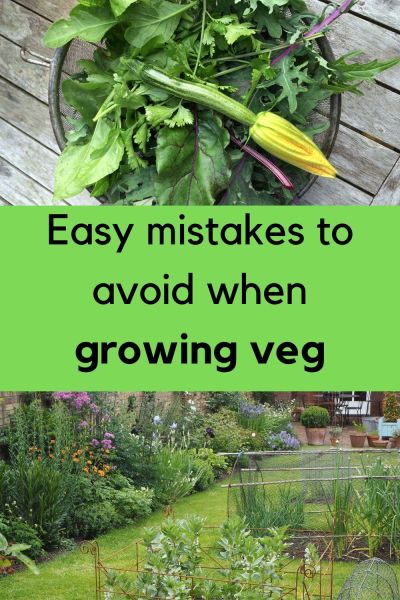
























Thank you so much for all this fabulous info in one place. I’ve just started growing my own veg this year and have been using Huw Richard’s excellent ‘Veg in One Bed’ and will now look into all your other suggestions.
One issue I’m trying to resolve at the moment is coming up with some kind of diary/planner system to remember all the jobs needing to be done daily, weekly, upcoming, etc and what care individual plants need. Is there a system you use particularly? Or can you recommend something like a veg gardener’s planner? Is there such a thing? I haven’t got a very good memory, to say the least!
Charles Dowding does a vegetable planner diary, and there’s also a YouTube channel called Grow Veg which does a very detailed garden planner: https://www.growveg.co.uk/garden-planner-intro.aspx The RHS also does a month by month ‘what to do in the garden’ – https://www.rhs.org.uk/advice/in-month/may – I hope one of those will help!
Peter Donegan (The Sod Show) stopped podcasting in Oct 2019, although it seems that past episodes are available.
Thank you for letting me know, I’ll find out from him if he plans to resume.
Very timely! Even up here in Scotland it feels like time to be planting and sowing. Thank your your uplifting pots and videos
Thank you!